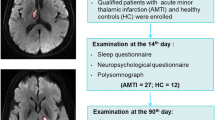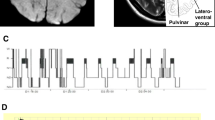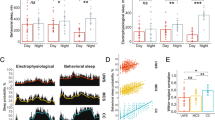Abstract
Background
Bilateral paramedian thalamic stroke is characterized by hypersomnia, vertical gaze palsy, amnestic alteration, and apathic state. Combined lesion of the paramedian thalamus and mesencephalon bilaterally is extremely rare. Little is known about the breathing disturbances of the particular region due to the lesion. The following describes the specific case of a woman, age 62, with bilateral paramedian thalamic and mesencephalic stroke. Initially, the patient’s complaints exhibited altered vigilance and vertical gaze palsy. Notably, following the acute phase, fluctuating hypersomnia was detected. The MRI (brain) revealed an ischemic lesion in the medial part of the mesencephalon and paramedian thalamus, bilaterally.
Aims
The aim of the present study is to elucidate the involvement and characteristics of sleep-related breathing abnormalities in the clinical manifestation of the combined paramedian thalamic and mesencephalic stroke.
Methods
Polysomnographic recordings were accomplished seven times with 1-week interval between the consecutive recordings, toward investigating the early changes of sleep and sleep-related breathing abnormalities.
Results
Sleep structure examination featured a decrease in N3 and REM ratio and an increase in N1 and N2 ratio with minimal improvement during the recovery period. In contrast, significant changes were found in the breathing pattern: the initial central apnea dominance was followed by obstructive apneas with a gradual decrease of the total pathological respiratory events.
Conclusion
In addition to the structural abnormality of the sleep regulating network, sleep-disordered breathing is another possible cause of hypersomnia in patients afflicted with the present localization of the lesion.


Similar content being viewed by others
References
Basetti C, Mathis J, Gugger M, Lövblad KO, Hess CW (1996) Hypersomnia following paramedian thalamic stroke: a report of 12 patients. Ann Neurol 39:471–80
Kumral E, Bayulkem G, Akyol A, Yunten N, Sirin H, Sagduyu A (2002) Mesencephalic and associated posterior circulation infarcts. Stroke 33:2224–31
Matheus MG, Castillo M (2003) Imaging of acute bilateral paramedian thalamic and mesencephalic infarcts. Am J Neuroradiol 24:2005–8
Meissner I, Sapir S, Kokmen E, Stein SD (1987) The paramedian diencephalic syndrome: a dynamic phenomenon. Stroke 18:380–5
Rangel-Castilla L, Gasco J, Thompson B, Salinas P (2009) Bilateral paramedian thalamic and mesencephalic infarcts after basilar tip aneurysm coiling: role of the artery of Percheron. Neurocirugia 20:288–93
Spengos K, Wohrle JC, Tsivgoulis G, Stouraitis G, Vemmos K, Zis V (2005) Bilateral paramedian midbrain infarct: an uncommon variant of the „top of the basilar” syndrome. J Neurol Neurosurg Psychiatry 76:742–43
Krolak-Salmon P, Croisile B, Houzard C, Setiey A, Girard-Madoux P, Vieghetto A (2000) Total recovery after bilateral paramedian thalamic infarct. Neurology 44:216–8
Bassetti CL (2005) Sleep and stroke. Semin Neurol 25:19–32
Harbison J, Ford GA, James OFW, Gibson GJ (2002) Sleep-disordered breathing following acute stroke. Q J Med 95:741–47
William L, Brown J, Loke Y, Kwok CS, Niruban A, Myint P (2013) Association of obstructive sleep apnoea (osa) with incident stroke: a systematic review and meta-analysis. J Neurol Neurosurg Psychiatry 84:e2
Floras JS (2013) Sleep apnea and cardiovascular risk. J Cardiol 28
Godoy J, Mellado P, Tapia J, Santín J (2009) Obstructive sleep apnea as an independent stroke risk factor: possible mechanisms. Curr Mol Med 9:203–9
Atkeson A, Yeh SY, Malhotra A, Jelic S (2009) Endothelial function in obstructive sleep apnea. Prog Cardiovasc Dis 51:351–62
Dumitrascu R, Heitmann J, Seeger W, Weissmann N, Schulz R (2013) Obstructive sleep apnea, oxidative stress and cardiovascular disease: lessons from animal studies. Oxidative Med Cell Longev 2013:234631
Guralnick AS (2013) Obstructive sleep apnea: incidence and impact on hypertension? Curr Cardiol Rep 15:415
Parra O, Arboix A, Bechich S et al (2000) Time course of sleep-related breathing disorders in first-ever stroke or transient ischemic attack. Am J Respir Crit Care Med 161:375–380
Askenasy JJM, Goldhammer I (1988) Sleep apnea as a feature of bulbar stroke. Stroke 19:637–39
Brown RE, Basheer R, McKenna JT, Strecker RE, McCarley RW (2012) Control of sleep and wakefulness. Physiol Rev 92:1087–187
Lassmann AB, Mayer SA (2005) Paroxysmal apnea and vasomotor instability following medullary infarction. Arch Neurol 62:1286–88
Nogués MA, Roncoroni AJ, Benarroch E (2002) Breathing control in neurological diseases. Clin Auton Res 12:440–49
Iber C, Ancoli-Israel S, Chesson LA, et al (2007) The AASM manual for the scoring of sleep and associated events. Rules, terminology and technical specifications. AMERICAN Academy of Sleep Medicine
Johnson KG, Johson DC (2010) Frequency of sleep apnea in stroke and TIA patients: a meta-analysis. J Clin Sleep Med 6(2):131–137
Bassetti C, Michael SA, Douglas Q (1997) Sleep-disordered breathing in patients with acute supra- and infratentorial strokes. Stroke 28:1765–1772
Howard RS, Rudd AG, Wolfe CD et al (2001) Pathophysiological and clinical aspects of breathing after stroke. Postgrad Med J 77:700–702
Lavie L (2005) Sleep-disordered breathing and cerebrovascular disease: a mechanistic approach. Neurol Clin 23:1059–75
Chokroverty, S and Montagna P (2009) Sleep, Breathing and neurologic disorders. In: Chokroverty S (ed) Sleep disorders medicine. pp. 436-498. Saunders
Bravata DM, Concato J, Fried T et al (2011) Continuous positive airway pressure: evaluation of a novel therapy for patients with acute ischemic stroke. Sleep 34:1271–7
Parra O, Arboix A (2012) Early treatment of obstructive apnea and stroke outcome. Sleep 35:747
Tomfohr LM, Hemmen T, Natarajan L et al (2012) Continuous positive airway pressure for treatment of obstructive sleep apnea in stroke survivors: what do we really know? Stroke 43:3118–23
Montagna P, Provini F, Plazzi G et al (2002) Bilateral paramedian thalamic syndrome: abnormal circadian wake-sleep and autonomic functions. J Neurol Neurosurg Psychiatry 73:772–74
Lau EY, Eskes GA, Morrison DL, Rajda M, Spurr KF (2013) The role of daytime sleepiness in psychosocial outcomes after treatment for obstructive sleep apnea. Sleep Disord 2013:140725
Heiss WD (2012) The ischemic penumbra: how does tissue injury evolve? Annals NY Acad Sci 1268:26–34
Conflict of interest
The authors reported no financial disclosure and conflict of interest.
Author information
Authors and Affiliations
Corresponding author
Rights and permissions
About this article
Cite this article
Faludi, B., Tóth, M., Pusch, G. et al. Dynamic changes in sleep-related breathing abnormalities in bilateral paramedian mesencephalon and thalamus stroke: a follow-up case study. Sleep Breath 20, 237–242 (2016). https://doi.org/10.1007/s11325-015-1212-0
Received:
Revised:
Accepted:
Published:
Issue Date:
DOI: https://doi.org/10.1007/s11325-015-1212-0




